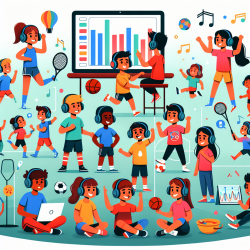Introduction
In the ever-evolving field of speech language pathology, practitioners are constantly seeking innovative approaches to enhance therapeutic outcomes for children. One such approach, as highlighted in the research article "Side by Side: Reflections on Two Lifetimes of Dance," involves the integration of dance and movement into therapeutic practices. This blog explores the potential benefits of incorporating dance into speech language therapy, drawing on the findings of the research and encouraging practitioners to delve deeper into this interdisciplinary approach.
The Role of Dance in Therapy
The research article by Kipling Brown and Penniston Gray underscores the profound impact of dance on both physical and mental health. Dance not only serves as a medium for self-expression but also fosters social inclusion and cultural connection. For children, these benefits are particularly significant as they navigate the complexities of communication and social interaction.
Incorporating dance into speech language therapy can offer several advantages:
- Enhanced Engagement: Dance can capture a child's interest and motivate them to participate actively in therapy sessions.
- Improved Communication: Movement and rhythm can aid in the development of speech and language skills by promoting auditory processing and motor planning.
- Emotional Expression: Dance provides a safe space for children to express emotions, which can be particularly beneficial for those with communication difficulties.
- Social Interaction: Group dance activities can encourage peer interaction and collaboration, fostering social skills.
Implementing Dance in Speech Language Therapy
To effectively integrate dance into therapy, practitioners should consider the following strategies:
- Collaborate with Dance Educators: Partnering with dance professionals can provide valuable insights and techniques for incorporating movement into therapy.
- Customize Activities: Tailor dance activities to meet the individual needs and goals of each child, ensuring that the movements are accessible and meaningful.
- Utilize Technology: Online platforms, such as those offered by TinyEYE, can facilitate virtual dance sessions, making therapy more accessible to children in remote areas.
- Foster Reflexivity: Encourage children to reflect on their dance experiences, promoting self-awareness and cognitive development.
Encouraging Further Research
While the benefits of dance in therapy are evident, further research is needed to quantify its impact and refine methodologies. Practitioners are encouraged to explore autoethnography as a research tool, as it allows for the examination of personal experiences and the generation of new insights. By documenting and analyzing the integration of dance in therapy, practitioners can contribute to a growing body of knowledge that supports data-driven decision-making in speech language pathology.
Conclusion
The intersection of dance and speech language pathology presents a promising avenue for enhancing therapeutic outcomes for children. By embracing interdisciplinary approaches and leveraging the power of movement, practitioners can create more engaging and effective therapy sessions. As we continue to explore the potential of dance in therapy, we must remain committed to evidence-based practices and ongoing research.
To read the original research paper, please follow this link: Side by Side: Reflections on Two Lifetimes of Dance.










